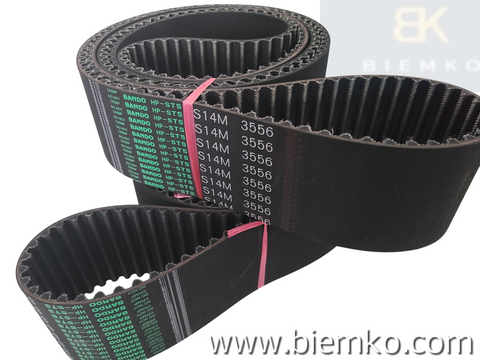
The purpose of timing belts is to synchronize the rotation of two or more shafts in industrial machinery. They are incredibly important components for a variety of applications, including motors and pumps, agricultural systems, automotive engines, and more. But what exactly does a timing belt do? And what are the types used for industrial machinery? This guide will help provide answers to these questions and more.
What Is a Timing Belt or Synchronous belt?
A timing belt is a mechanical device that is used to synchronize the rotation of two or more shafts in an internal combustion engine or other machines. This is why these components are also known as synchronous timing belts and pulleys.
A timing belt works by connecting two pulleys together using specially designed rubber teeth that mesh together as the pulleys rotate. The teeth not only transfer motion between the pulleys but also control the speed at which they move relative to each other. This ensures that all components of the system rotate in sync, allowing for smoother operation and greater efficiency.
Synchronous belts are typically constructed from strong synthetic materials such as neoprene or polyurethane, while their accompanying pulleys are made from durable metals such as steel or aluminum for maximum strength and wear resistance. With proper maintenance, these components can provide reliable performance for many years to come in demanding applications such as medical devices, robotics, aerospace systems, and more.
Types of Timing Belts
Timing belts come in various sizes and materials, including polyurethane timing belts and neoprene timing belts, as it was mentioned above.
Depending on your application, you may require a specific type of material for optimal performance. Let’s see some details.
Polyurethane timing belts
Polyurethane timing belts can be a great choice for the automation of assembly lines. This type of belt has proven to be both reliable and durable, making it ideal for long-term use in complex automated systems. It has become increasingly popular due to its high resistance to wear and tear, as well as its capacity to handle higher loads while still maintaining accuracy.
Gates belts are a great example of this type. Biemko offers polyurethane timing belts manufactured by Gates in a wide variety of sizes. Check them out to find the best timing belt for your application.
Neoprene timing belts
Neoprene timing belts are high-performance and reliable components used in an array of industrial applications. These belts are well-suited for power transmission at moderate speeds, often used in production machinery, robotic arms, and conveyor systems. With a durable rubber construction that is reinforced with fiberglass yarn or polyester cord, neoprene timing belts have superior flex fatigue and dimensional stability.
Bando is one of the top manufacturers of neoprene timing belts. If you are wondering where to buy Bando belts, or where to find a specific Bando timing belt, you can check our stock of neoprene timing belts by Bando. We are sure you will find the one you need.
Timing belts tooth profiles
Like V-Belts have different profiles, timing belts come in different types of tooth profiles meaning different characteristics of the cross-section of their teeth.
For timing belts, there are different tooth profiles and depending on the application, certain profiles may be more suitable than others. The most popular types are the trapezoidal profile, the curvilinear profile, and the modified curvilinear profile. Let’s see some details.
Trapezoidal timing belts
The main profiles of trapezoidal timing belts are MXL, XL, and L profiles. The main difference among the three is the separation between teeth called the pitch. The standard pitch for each profile is:
- MXL belt - .08 inches (2.03mm)
- XL belt - .2 inches (5.08mm)
- L belt - .375 inches (9.525mm)
These belts represent an efficient and reliable mechanical power transmission solution for a variety of industrial applications such as HVAC systems and CNC machines.
For example, the Bando 115MXL3.2G Timing Belt is a cost-effective power transmission solution often used HVAC systems.
Curvilinear timing belt
Also known as rounded tooth profile, the curvilinear profile consists primarily of rounded edges but also includes sharp points at each end for increased grip strength and durability. This shape provides superior shock absorption compared to other shapes and makes it ideal for use in high-impact machineries like escalators or conveyor belts where consistent performance is necessary to ensure safety and proper operation.
These belts where first developed by Gates and named High-Torque Drives (HTD). This designation is still in use, but different manufacturers may use different names. For example, Bestorq also uses HTD to refer to their curvilinear profile timing belts, while Bando only uses HT (High Torque).
HTD belts with small pitch sizes are perfect for light power applications where precise positioning matters, including:
- Small power tools.
- Small kitchen appliances like food processors.
- Office machines like printers.
- Home appliances like sewing machines and vacuum cleaners,
- Medical equipment.
- Vending machines.
On the other hand, HTD belts with larger pitch sizes work well in heavy machinery used in different industries, such as:
- Manufacturing
- Construction
- Mining
- Oil and Gas
For example, HTD belts with 14mm like the Bestorq 1064-14M-140 timing belts are a great choice for the industrial type fans used in the oil and gas industry.
Modified curvilinear teeth timing belts
Another type of timing belt tooth profile is the modified curvilinear shape. This type of profile has curved sides and pointed teeth making it well-suited for applications where a tighter grip and smoother operation are desired. It provides less drag on the motor and can increase efficiency while reducing heat buildup in high-speed operations such as in robotic arms or robotic drives.
These belts are always provided in metric dimensions with standard pitches starting from 2 mm. From there, you can select from a range of widths usually measured in millimeters.
A good example of modified curvilinear tooth profile application is the Gates Poly Chain GT Carbon line, which features belts that are a great replacement for roller chain drives in the energy, exploration and extraction industry as describe by this case study. Another premium belt drive with a modified curvilinear section is the Gates Powergrip GT Belt. Commonly used for a wide array of applications to include hand tools, business machines, domestic appliances and high precision servomotor drives. The 8MGT and 14MGT pitches are the optimal choice for high performance drives in the machine tool, paper and textile industries where durability and low maintenance are required. Also perfect for heavy manufacturing, automated production and custom assembly.
Closing Remarks
At Biemko, we distribute a wide variety of power transmission timing belts and belt drives to keep your machinery and equipment working smoothly and effectively. We sell light-duty to heavy-load equipment timing belts for various commercial and industrial sectors.
If you already know what belt you need, you can explore our comprehensive range of Gates, Bando, Bestorq timing belts, and all other specialty belts. Of course, if you need assistance in finding a timing belt or have any other inquiries, do not hesitate to Contact Us or chat with us online.

